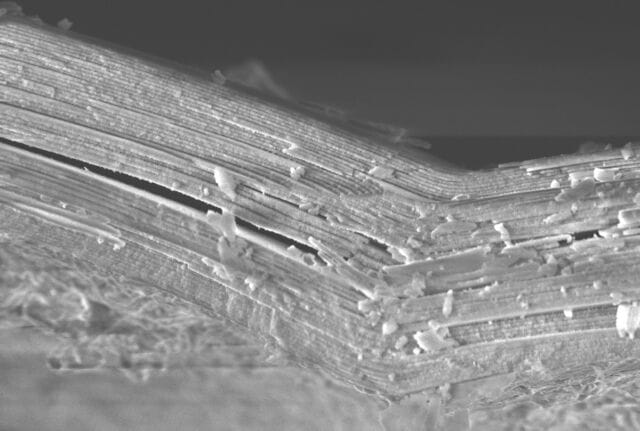
Imagine for a moment that you’re strolling through a bustling Roman marketplace some 2,000 years ago. A glass vessel, possibly filled with wine, water, or even an exotic perfume, unbalances and falls from a merchant’s table and shatters on the cobblestone streets. Clean up on aisle five!
But this time the street sweeper was clumsy. Over the centuries, nature has taken its course. Layers of dust, soil, temperature fluctuations, and varying moisture levels concealed these glass shards from the world but also morphed them into something surprising.
Fast forward to today, when these very fragments have been rediscovered at an archaeological site in Italy. What were once ordinary shards of glass now exhibit iridescent mosaics of blue, green, and orange. Some even glisten with a gold sheen.
While you may usually find such captivating relics gracing jewelry or museum displays, for researchers Fiorenzo Omenetto and Giulia Guidetti, it’s the story that these pieces tell about their transformation that’s truly extraordinary. They were stunned, for example, to find that the glass fragments combined with minerals and over thousands of years gained physical properties analogous to those of components found in high-tech applications.
Nature’s ingenious craftsmanship

The ever-curious minds of Omenetto and Guidetti, both professors at the Tufts University Silklab, delved deeper into the intriguing phenomenon that had turned plain glass into shimmering wonders. What they found was that Roman glass turned into photonic crystals — meticulously ordered atomic arrangements that influence light in specific ways.
Photonic crystals are structures with periodic dielectric properties that affect the propagation of electromagnetic waves. Typically, they are manufactured using advanced fabrication techniques, such as lithography, which allows for precise patterning on the nanoscale. In the process, layers or arrays of materials with varying refractive indices are systematically arranged, creating periodicity (repeating molecular arrangements) in one, two, or three dimensions. This periodic structure results in a photonic bandgap, which restricts certain wavelengths of light from propagating through the crystal.
These photonic crystals play pivotal roles in our digital age. They’re the backbone of ultra-fast optical communication devices, including waveguides and switches that power our computers and internet. Moreover, their ability to manipulate light finds applications in light filters, lasers, mirrors, and even stealth devices.
It’s a fascinating juxtaposition: an artifact from a civilization that predates the internet by millennia can somehow gain properties fundamental to modern optical communication.
“It’s akin to stumbling upon a textbook example of a nanophotonic component in the mud,” remarked Omenetto.
An accidental discovery shrouded in glistering beauty
The amazing discovery was initially serendipitous. Omenetto was visiting the Italian Institute of Technology’s Center for Cultural Heritage Technology where a sparkling fragment caught his eye. The Institute’s director told him that this was a Roman glass fragment originating from the ancient city of Aquileia, which the local researchers affectionately termed the ‘wow glass’. That’s when they decided to take a closer look.
Chemical analysis showed that the glass fragments were initially forged sometime between 100 BCE and 100 CE, during a time when Rome transitioned from a republic into an empire. The silica came from the sands of Egypt, and perhaps the glass itself was made there, highlighting the busy trade networks between the two great powers. But there was much more to this sparking glass.

By employing state-of-the-art scanning electron microscopes, Omenetto and Guidetti could visualize the gold-reflective patina’s intricate structure. They observed what resembled Bragg stacks — alternating layers of silica that reflect specific light wavelengths.
“This is likely a process of corrosion and reconstruction,” said Guidetti. “The surrounding clay and rain determined the diffusion of minerals and a cyclical corrosion of the silica in the glass. At the same time, the assembly of 100 nanometer-thick layers combining the silica and minerals also occurred in cycles. The result is an incredibly ordered arrangement of hundreds of layers of crystalline material.”
This insight could prove valuable. What if researchers can speed up this process to mass-produce optical material? Instead of manufacturing, we might just grow them!
From decay to brilliance
Rome, with its enduring structures like aqueducts, roads, and temples, reflects a persistence akin to its glass. Structures rise and fall, influenced by wars, societal shifts, and time’s relentless march. Just as the city evolved, the very crystals on the glass serve as chronicles of its environmental history, according to Guidetti.
In a world where past and present often intertwine, these age-old glass fragments, with their tales of transformation, remind us of nature’s endless capacity for wonder. Who would’ve thought that a simple shard from yesteryear could illuminate the intricacies of modern science? Nature, as always, remains the greatest artist and innovator of all.
The findings appeared in the Proceedings of the National Academy of Sciences.


